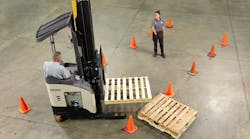We’ve all been in a situation on a long road trip where we’ve pushed the gas gauge to the max and rushed to the gas station. Our expectation is that in a manner of minutes, we will be refueled and back on the road heading back towards our final destination. But imagine if when you got to the fuel pump, it was refueling at a painstakingly show rate. Instead of a couple of minutes you had to wait 15-60 minutes for your tanked to be replenished. Your kids would be whining, your significant other would be upset, and you would likely be extremely frustrated. You would also look at the GPS after the tank was full and realize the lost productivity in your trip immediately
This seems like an unfathomable scenario as we wouldn’t tolerate waiting additional time for our personal vehicle to refuel.
Yet, among those of us who lead and manage manufacturing and distribution sites, waiting for a forklift to refuel is a common and expected occurrence. We’re accustomed to that wait time when it comes to powering our forklifts—after all, that’s just how forklift power works. Right?
In my years spent working with hundreds of professionals in manufacturing, distribution, operations, and facility maintenance, I’ve met very few who understand (let alone adopt) the principles of efficient forklift power management. Those that “get it” understand that time is money, and the minutes that tick by as they recharge their invaluable forklifts can be counted in hundreds of thousands of dollars over the life of the forklift.
The question I would like to pose is, should we view forklift charging as a downtime event? I would suggest it’s high time this industry started examining and troubleshooting this downtime with the same haste and ingenuity we bring to every other obstacle causing operational inefficiency. It’s this simple—powering your forklift is a downtime event.
After all, just look at the landscape today. We’re spending countless sums of money on automation, advanced equipment, specialized training and high tech solutions—all in the name of increased throughput. Because we understand that increased throughput directly correlates to increased profits and a competitive advantage. The more quickly and consistently you can be up and running at full steam, the more your team and organization will ultimately benefit as a result.
We understand these concepts when it comes to so many contributors to downtime, yet we’re still plugging in our forklift batteries and waiting untold amounts of time for them to be charged and functional again. We don’t evaluate and assess options around our forklift power, we don’t test new solutions to determine whether charging time is reduced—we simply take it for granted that our forklift batteries have to be charged when they have to be charged, and they take the time they take to do so.
Forklift manufacturers might go to great lengths to disprove this, but in my experience (and supported by the experiences of many experienced colleagues in the industry), all forklifts—no matter the make, model and cost—perform in essentially the same way, at close to the same level of efficiency.
But the same definitely can’t be said of forklift power sources and solutions.
There is now an entire industry devoted to forklift power, with emergent solutions cropping up every day. Best practice leaders in our field are now developing detailed energy security plans with nuanced approaches to powering their critical equipment. They’re working with expert partners who work exclusively in the field of equipment power and have their finger on the pulse of emerging trends. And they’re getting smart and crafty about putting back-up power solutions in place for downtime periods.
If exploring and activating that emerging technology meant you could cut your forklift charging time (aka downtime) in half, what might that mean for your day-to-day operational milestones? How might your numbers improve as a result?
More and more I see folks in our industry looking at their facilities, operations and equipment differently. We all want to find novel, game-changing ways to meet our targets and deliver on our promises. We all want more. And I for one fully support this spirit of ingenuity, innovation and enthusiasm sweeping across our spaces. But it’s time we bring that same kind of thinking and energy to our tried-and-true methods for powering our commonly used equipment. Our forklifts are absolutely integral to the work we do—we have to start thinking of their power in the same way.
TJ Shelters is national vice president of sales at Concentric, a provider of DC power management and on-site maintenance for the material handling and critical power industries.



